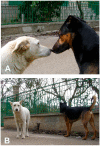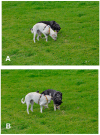Communication in Dogs
- PMID: 30065156
- PMCID: PMC6116041
- DOI: 10.3390/ani8080131
Communication in Dogs
Abstract
Dogs have a vast and flexible repertoire of visual, acoustic, and olfactory signals that allow an expressive and fine tuned conspecific and dog⁻human communication. Dogs use this behavioural repertoire when communicating with humans, employing the same signals used during conspecific interactions, some of which can acquire and carry a different meaning when directed toward humans. The aim of this review is to provide an overview of the latest progress made in the study of dog communication, describing the different nature of the signals used in conspecific (dog⁻dog) and heterospecific (dog⁻human) interactions and their communicative meaning. Finally, behavioural asymmetries that reflect lateralized neural patterns involved in both dog⁻dog and dog⁻human social communication are discussed.
Keywords: behaviour; communication; dog.
Conflict of interest statement
The authors declare no conflict of interest.
Figures










References
-
- Thalmann O., Shapiro B., Cui P., Schuenemann V.J., Sawyer S.K., Greenfield D.L., Germonpré M.B., Sablin M.V., López-Giráldez F., Domingo-Roura X., et al. Complete mitochondrial genomes of ancient canids suggest a European origin of domestic dogs. Science. 2013;342:871–874. doi: 10.1126/science.1243650. - DOI - PubMed
-
- Kaminski J., Nitzschner M. Do dogs get the point? A review of dog–human communication ability. Learn. Motiv. 2013;44:294–302. doi: 10.1016/j.lmot.2013.05.001. - DOI
Publication types
LinkOut - more resources
Full Text Sources
Other Literature Sources

